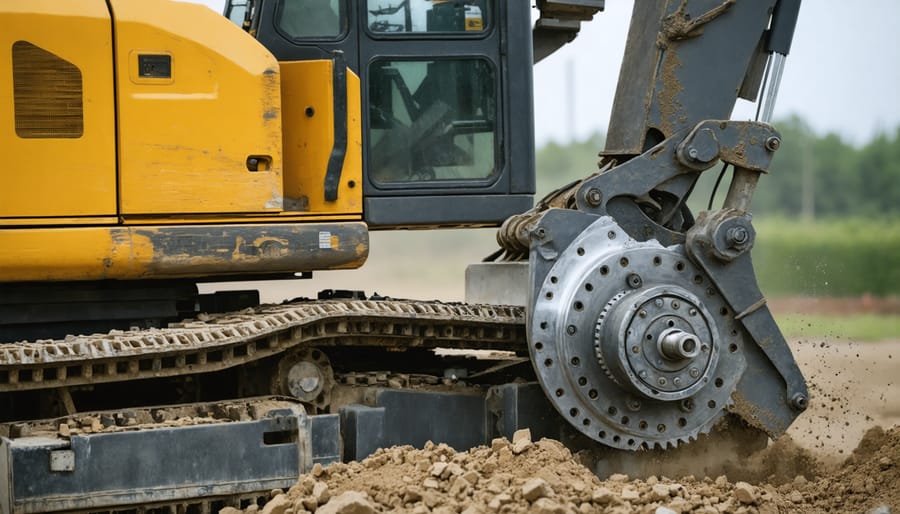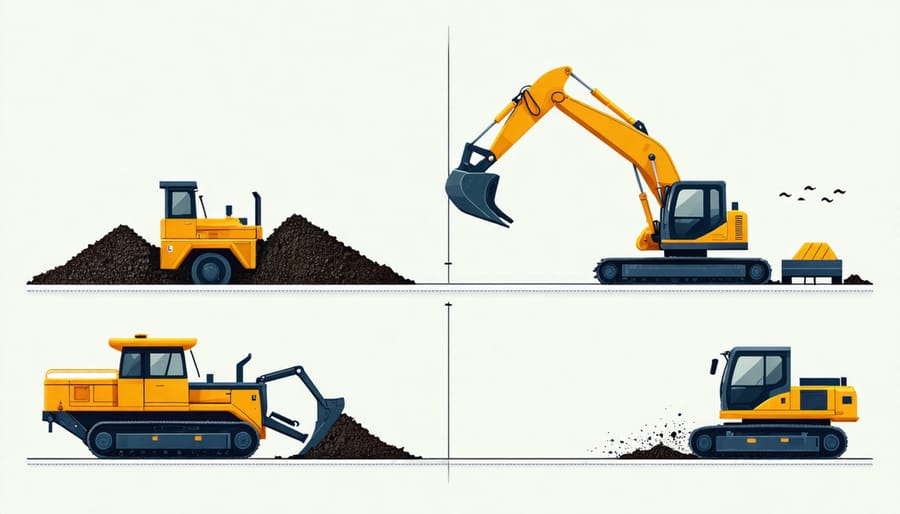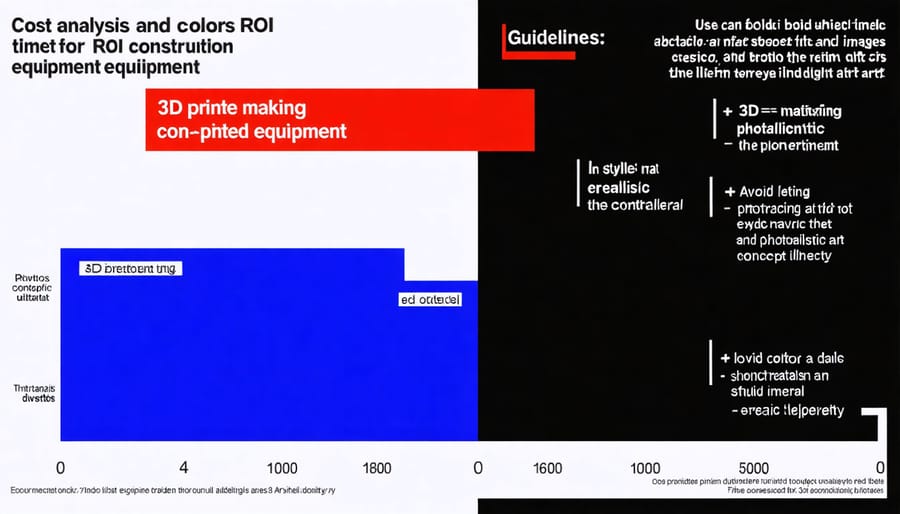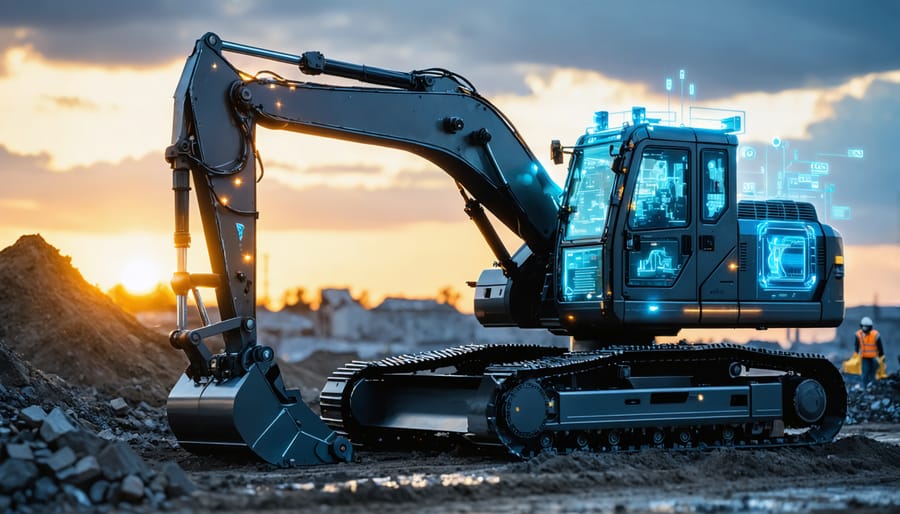3D printing technology is revolutionizing how construction equipment is manufactured, emerging as one of the most transformative construction innovations of the decade. By enabling rapid prototyping and on-demand production of complex components, this technology is dramatically reducing lead times from months to days while cutting production costs by up to 60%. Industry leaders like Caterpillar and Komatsu are already leveraging additive manufacturing to produce specialized parts, custom tooling, and replacement components that previously required extensive machining or casting processes.
The integration of 3D printing in construction equipment manufacturing represents a paradigm shift in how the industry approaches equipment design, maintenance, and supply chain management. From printing lightweight yet durable excavator cabins to creating complex hydraulic manifolds with optimized flow channels, the technology enables design freedom and functionality that traditional manufacturing methods simply cannot match. This advancement is particularly crucial as construction firms face increasing pressure to improve efficiency, reduce downtime, and maintain competitiveness in a rapidly evolving market.
Current Applications of 3D Printed Construction Equipment
Replacement Parts and Components
The emergence of 3D printing technology has revolutionized the maintenance and repair of construction equipment, offering unprecedented flexibility in parts manufacturing. As part of the broader 3D printing revolution in construction, equipment manufacturers and construction companies are increasingly turning to additive manufacturing for replacement parts production.
This technology enables the rapid production of both standard and hard-to-find components, significantly reducing equipment downtime. Construction firms can now print critical parts on-demand, including hydraulic fittings, bracket assemblies, and custom-designed components that may no longer be available from original manufacturers.
The advantages are particularly evident in remote construction sites, where traditional parts procurement can cause substantial delays. By implementing on-site 3D printing capabilities, companies can maintain their equipment fleet more efficiently and reduce inventory costs. Recent case studies show that construction firms using 3D-printed replacement parts have reported up to 60% cost savings compared to traditional procurement methods.
Materials used in 3D-printed parts have also evolved significantly, now including high-strength polymers, metal alloys, and composite materials that meet or exceed OEM specifications. Quality control processes, including stringent testing protocols and material certification, ensure that printed components maintain the necessary durability and reliability for heavy-duty construction applications.

Specialized Tools and Attachments
3D printing technology has revolutionized the production of specialized tools and attachments for construction equipment, enabling the creation of custom solutions that address specific jobsite challenges. Construction companies are now leveraging this technology to manufacture unique components that enhance equipment functionality and improve operational efficiency.
Notable examples include custom-designed bucket attachments for excavators, featuring optimized geometries for specific soil conditions or material handling requirements. These 3D-printed attachments often incorporate complex internal structures that would be difficult or impossible to achieve through traditional manufacturing methods.
Tool holders and mounting brackets manufactured through 3D printing allow for precise equipment modifications, accommodating specialized sensors, cameras, or auxiliary equipment. Companies have successfully produced lightweight yet durable boom extensions and articulating arms that reduce overall equipment weight while maintaining structural integrity.
Other innovative applications include customized nozzles for concrete pumping equipment, featuring internal flow channels designed to optimize material delivery and reduce clogging. Quick-connect coupling systems and adaptors manufactured through 3D printing enable rapid tool changes and enhanced equipment versatility.
The technology also facilitates the production of ergonomic control handles and operator interface components, tailored to specific equipment models and operator preferences. These customized solutions often integrate seamlessly with existing equipment, extending functionality without compromising safety or reliability.
Maintenance teams particularly benefit from 3D-printed diagnostic tools and testing equipment designed for specific machine models, streamlining repair processes and reducing equipment downtime.
Technical Considerations and Materials

Advanced Materials for Durability
The evolution of advanced building materials has revolutionized how construction equipment components are manufactured through 3D printing. High-performance polymer composites, reinforced with carbon or glass fibers, have emerged as primary materials for producing wear-resistant parts. These materials offer superior strength-to-weight ratios and exceptional durability under harsh construction site conditions.
Metal-based materials, particularly steel alloys and titanium composites, are increasingly utilized for critical components that require maximum structural integrity. Advanced powder metallurgy techniques enable the creation of complex geometries while maintaining exceptional mechanical properties. Recent developments in metal matrix composites have shown promising results in improving wear resistance and thermal stability of printed parts.
Ceramic-based materials and cermets have found applications in components exposed to extreme temperatures and abrasive conditions. These materials exhibit outstanding hardness and wear resistance, crucial for components like bucket teeth and wear plates. Innovative binding agents and sintering processes have overcome traditional challenges in 3D printing ceramic materials.
Material scientists have also developed specialized coating solutions that enhance the performance of 3D printed components. These include nano-engineered surface treatments that improve wear resistance and self-lubricating coatings that extend component lifespan. Recent research indicates that hybrid materials, combining multiple material types in single components, can optimize performance for specific applications while reducing overall equipment weight.
Quality control protocols for these materials have become increasingly sophisticated, with real-time monitoring systems ensuring consistent material properties throughout the printing process. This advancement has significantly improved the reliability and predictability of 3D printed construction equipment components.
Quality Control and Testing
Quality control in 3D-printed construction equipment manufacturing demands rigorous testing protocols and standardized procedures to ensure reliability and compliance with industry regulations. The process begins with comprehensive material testing, where printed components undergo strength analysis, durability assessments, and environmental resistance evaluations.
Non-destructive testing (NDT) methods play a crucial role in quality assurance. Ultrasonic testing and X-ray inspection help identify internal defects, voids, or structural inconsistencies that might compromise equipment performance. These techniques allow manufacturers to verify the integrity of printed parts without compromising their functionality.
Dimensional accuracy testing ensures that printed components meet specified tolerances. Advanced metrology equipment, including 3D scanners and coordinate measuring machines (CMMs), verifies that each part maintains precise measurements essential for proper equipment operation and component integration.
Performance testing subjects printed parts to real-world conditions, simulating actual construction site environments. This includes load testing, stress analysis, and weather exposure trials. Equipment undergoes cyclic loading tests to evaluate fatigue resistance and long-term durability.
Quality control documentation maintains detailed records of printing parameters, material certifications, and test results. This documentation ensures traceability and compliance with industry standards while facilitating continuous improvement in manufacturing processes.
Manufacturing facilities implement in-process quality control measures, monitoring critical parameters such as print temperature, speed, and layer adhesion during production. Advanced monitoring systems with real-time feedback capabilities allow for immediate adjustments to maintain quality standards.
Regular calibration of 3D printing equipment and validation of printing parameters ensures consistent output quality. This systematic approach to quality control helps manufacturers deliver construction equipment that meets safety requirements and performance expectations while maintaining regulatory compliance.
Cost-Benefit Analysis
Initial Investment vs. Long-term Savings
The decision to invest in 3D printing construction equipment requires careful analysis of both immediate costs and long-term financial benefits. Initial equipment costs typically range from $150,000 to $1.5 million, depending on the scale and capabilities of the system. Additional expenses include software licenses, training programs, and facility modifications to accommodate the new technology.
However, case studies from leading construction firms demonstrate significant cost savings over time. A recent analysis by Turner Construction showed a 30% reduction in equipment maintenance costs and a 40% decrease in replacement part expenses after implementing 3D printing for component manufacturing. Material waste reduction of up to 60% further contributes to long-term savings.
Labor cost optimization presents another compelling advantage. While specialized operators command higher salaries, the overall labor requirement decreases as one operator can manage multiple printing operations simultaneously. Companies report average labor cost reductions of 25-35% in equipment maintenance departments.
Return on investment typically occurs within 2-3 years for companies that maintain regular equipment production schedules. This timeline shortens for organizations that leverage the technology for multiple applications, such as prototype development and spare parts manufacturing. Additionally, the ability to produce parts on-demand reduces inventory carrying costs by approximately 40%, contributing to improved cash flow management.
For maximum financial benefit, companies should conduct thorough utilization forecasts and develop clear implementation strategies before making the investment.

Maintenance and Operational Benefits
The integration of 3D-printed components in construction equipment has revolutionized maintenance protocols and operational efficiency across job sites. Equipment manufactured using additive manufacturing techniques demonstrates remarkable durability while requiring significantly less maintenance than traditionally manufactured parts. This advancement has led to measurable improvements in construction site efficiency and equipment uptime.
One of the primary advantages is the ability to rapidly produce replacement parts on-demand, effectively reducing equipment downtime from weeks to mere hours. When a component fails, construction companies can now print exact replacements instead of waiting for manufactured parts to arrive from suppliers. This capability is particularly valuable for legacy equipment where original parts may no longer be available.
The layer-by-layer construction process of 3D printing allows for the creation of components with optimized internal structures, resulting in better wear resistance and longer service life. Case studies have shown that 3D-printed parts can reduce maintenance frequency by up to 30% while extending component lifespan by 40-50% compared to traditional manufacturing methods.
Additionally, the technology enables predictive maintenance through the integration of sensors and monitoring systems directly into printed components, allowing teams to address potential issues before they lead to costly breakdowns. This proactive approach has proven to reduce unexpected equipment failures by up to 25% in pilot programs across major construction firms.
Future Outlook and Industry Impact
The future of 3D printed construction equipment promises transformative changes across the industry. Industry analysts predict a compound annual growth rate of 14.3% in the 3D printed construction equipment market through 2028, driven by increasing demand for customized solutions and sustainable manufacturing practices.
Emerging trends indicate a shift toward hybrid manufacturing systems that combine traditional methods with additive manufacturing. These systems will enable manufacturers to produce equipment components with complex geometries while maintaining structural integrity and reducing material waste. Advanced materials development, including high-performance polymers and metal composites, will expand the possibilities for printing critical components that meet stringent performance requirements.
Artificial intelligence and machine learning integration will revolutionize the design optimization process, allowing for automated generation of parts that are lighter, stronger, and more efficient than traditional designs. This evolution will lead to equipment that consumes less fuel, requires fewer maintenance interventions, and offers enhanced operational capabilities.
The industry can expect significant developments in on-site printing capabilities, with mobile 3D printing units becoming more common at construction sites. These units will enable rapid replacement of worn parts and custom modifications to meet specific project requirements, dramatically reducing equipment downtime and transportation costs.
Environmental sustainability will drive innovation in recyclable materials and closed-loop manufacturing systems. Construction equipment manufacturers are already developing processes to repurpose end-of-life printed components, creating a more sustainable lifecycle for construction machinery.
Looking ahead, industry experts anticipate the emergence of fully printed construction equipment within the next decade. This development will revolutionize equipment manufacturing, enabling rapid deployment of machinery in remote locations and disaster relief scenarios. The integration of Internet of Things (IoT) sensors during the printing process will also enhance equipment monitoring and predictive maintenance capabilities.
These advancements will require new skillsets within the construction industry, creating opportunities for specialized training and certification programs. As the technology matures, standardization efforts will ensure consistency and reliability across printed components, fostering wider adoption among traditional equipment manufacturers.
The integration of 3D printing technology in construction equipment manufacturing represents a significant shift in how the industry approaches equipment production and maintenance. As we’ve explored throughout this article, the benefits of this technology extend far beyond mere prototyping, offering tangible advantages in terms of cost reduction, design optimization, and operational efficiency.
For construction professionals looking to leverage this technology, the key considerations remain clear. The initial investment in 3D printing capabilities must be balanced against long-term benefits, including reduced maintenance costs, faster parts replacement, and enhanced equipment customization options. The ability to produce complex geometries and lightweight components while maintaining structural integrity presents unprecedented opportunities for equipment innovation.
Looking ahead, the construction industry can expect continued evolution in 3D printing applications. As materials science advances and printing technologies become more sophisticated, we’ll likely see broader adoption across various equipment categories. The potential for on-site printing facilities could revolutionize equipment maintenance and spare parts management, particularly in remote locations.
For decision-makers considering implementation, the recommendation is to start with smaller-scale applications while developing a comprehensive strategy for broader adoption. Success lies in identifying specific areas where 3D printing can provide immediate value while building expertise and infrastructure for future expansion. Training staff and establishing quality control protocols will be crucial for maximizing the technology’s potential.
The future of construction equipment manufacturing increasingly points toward additive manufacturing as a core technology, making it essential for industry professionals to stay informed and prepared for this transformation.

